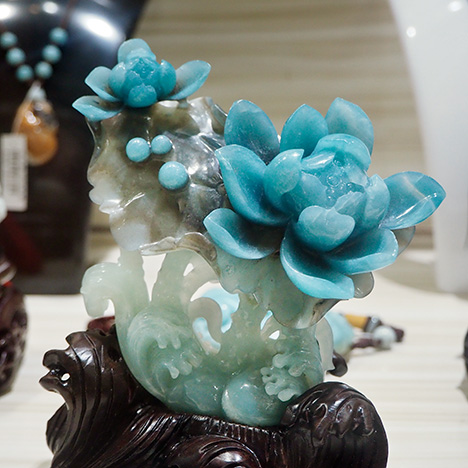Guizhou Jade from Qinglong, China

A green-blue quartzite produced in the Qinglong antimony deposit, in southwestern Guizhou Province, is called Guizhou Jade in the trade. The source area is located in the middle of the Yunnan-Guizhou Plateau at 25°N latitude, rising 1,600 meters (5,250 ft) above sea level (figure 1). This material was discovered in the 1950s, when the antimony deposit was economically more important to the area. The accompanying blue quartzite was only commercially mined as a decorative material. Later, it was used as a gem material, and it has been popular in Chinese jade markets since about 2011 (figure 2).

In June 2018, the authors went to the source to inspect the antimony deposit and conduct exploration and collection for Guizhou Jade in the mine. The host rocks are mainly pyroclastic (breccia) rocks, breccia clay rocks of the Dachang layer, and bio-limestones of the Maokou Formation. The Dachang layer is the main ore-bearing layer of the antimony deposit, which is a set of pyroclastic and chemical deposits, and subjected to alteration to siliceous and clay rocks (J.C. Cao, “The dyeing mechanism and cause of Guicui,” Acta Mineralogica Sinica, No. 3, 1983, pp. 183–192).

The authors observed that in the mine, this material has a close relationship with stibnite. It is mostly developed in the interlayer fissures, fracture zones, and areas where brecciation has taken place. The material occurs as blocks and/or veins (figure 3). In the ores, there are calcite- and gypsum-filled cracks and voids. Green or white clay minerals are often found in the micro-cracks or small holes in the gem material.

Guizhou Jade is translucent to opaque, with a refractive index of about 1.54 (spot reading), a specific gravity of 2.62, and a Mohs hardness of 6.5–7. According to the infrared spectrum, the main constituent mineral is quartz, and its infrared spectrum matches the α-quartz standard infrared spectrum, including several obvious absorption peaks at 1172, 1124, 1085, 798, 781, 540, and 478 cm–1 (figure 4). Quartzite is generally cryptocrystalline. Its colors range from light green-blue to dark green-blue. The most sought-after color is ocean blue, as shown in figure 2.

UV-Vis-NIR absorption spectra (figure 5) of both samples show an obvious 415 nm absorption band and a strong absorption band at 590–620 nm, located in the blue-green range of visible light. The absorption intensity of the light-colored sample is significantly lower than that of the deep-colored sample. The 415 nm absorption band is caused by 4A2g→4T1g transition and 4A2g→4T2g transition of Cr3+. The strong absorption band at 590 to 620 nm is caused by charge transfer between Fe2+→Ti4+ and 4A2g→4T2g transition of Cr3+ (J. Liu, “The color formation of common green quartz jade,” Ming Ri Feng Shang, No. 3, 2017, pp. 368–371).
High-quality Guizhou Jade is rich in color and loved by collectors. It has been widely used in necklaces, bracelets, earrings, and other items.



